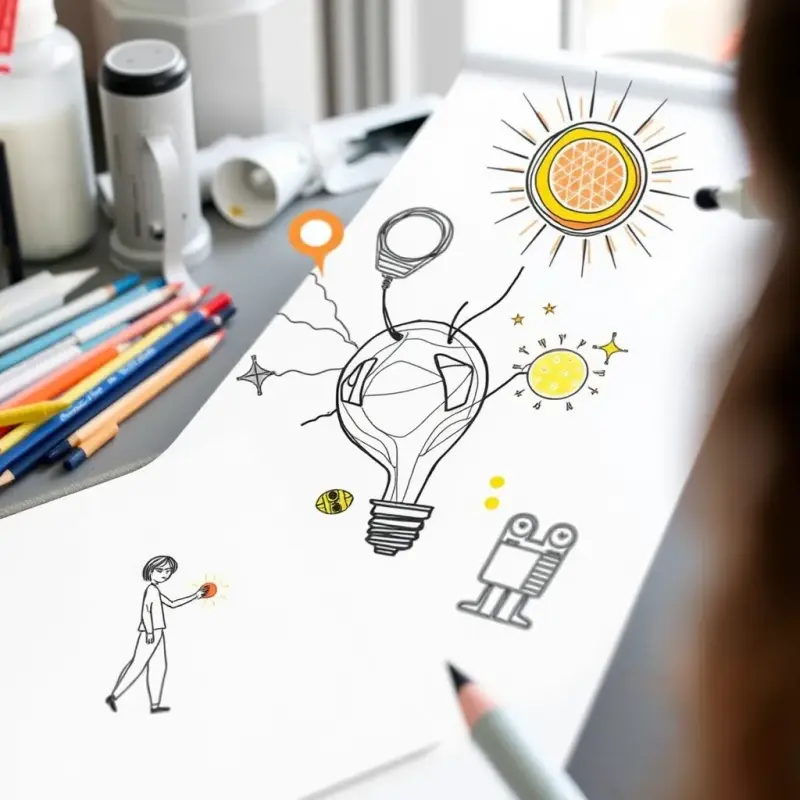How to Develop Creative Thinking Through Experimental Drawing: Techniques and Examples
Creative thinking is an essential skill for both personal and professional growth. One effective way to enhance this ability is through experimental drawing. By exploring unconventional methods of creating art, individuals can foster their imagination, discover new perspectives, and expand their problem-solving capabilities. This article delves into various experimental drawing techniques and offers practical examples to inspire and guide your creative journey.
The Role of Experimental Drawing in Creativity
Experimental drawing breaks away from traditional methods, encouraging artists to embrace spontaneity and exploration. It emphasizes process over outcome, allowing for mistakes and unexpected results to become part of the artistic expression. This approach nurtures flexibility of thought, enabling creators to view challenges as opportunities and develop innovative solutions.

Techniques for Experimental Drawing
1. Monotype Printing
Monotype printing involves creating a single, unique impression by transferring paint or ink from a smooth surface onto paper. Here’s how to try it:
-
Apply ink or paint onto a glass or acrylic plate.
-
Manipulate the medium using brushes, rollers, or even your fingers.
-
Press a sheet of paper onto the plate and peel it off to reveal your design.
This technique produces unpredictable textures and patterns, sparking new ideas and visual possibilities.
2. Frottage
Frottage, or rubbing, is a simple yet powerful technique:
-
Place a sheet of paper over a textured object such as wood, fabric, or metal.
-
Rub a pencil, crayon, or charcoal over the surface.
The resulting image captures the texture’s details, often inspiring further creative exploration. Frottage can be used to create abstract designs or add depth to figurative works.
3. Collage
Collage involves assembling different materials to form a cohesive piece of art. This method encourages the blending of various media and ideas:
-
Gather materials like magazine clippings, fabric scraps, or natural objects.
-
Arrange and glue them onto a base surface.
-
Combine drawing or painting to enhance your composition.
Collage fosters associative thinking by encouraging you to connect disparate elements into a unified whole.
4. Blind Contour Drawing
Blind contour drawing enhances observational skills and intuition:
-
Focus on an object without looking at your paper.
-
Draw its contours in one continuous line.
This exercise disconnects the analytical mind and emphasizes the hand-eye connection, often leading to surprising and expressive results.
5. Automatic Drawing
Automatic drawing taps into the subconscious by prioritizing flow over control:
-
Use a pen or pencil to create freeform lines and shapes without a plan.
-
Allow your hand to move instinctively across the page.
The abstract forms generated can serve as a foundation for more detailed works or standalone pieces.
6. Mixed Media Experiments
Combine various tools and materials to push the boundaries of traditional drawing:
-
Layer watercolor washes with graphite sketches.
-
Incorporate digital editing into hand-drawn elements.
-
Use unconventional tools like sponges, sticks, or string to apply color and texture.
Mixed media opens up endless possibilities for exploration and innovation.
Benefits of Experimental Drawing
Engaging in experimental drawing provides numerous benefits beyond artistic development:
-
Enhanced Problem-Solving: Experimenting with different approaches encourages adaptive thinking.
-
Stress Relief: The process-oriented nature of these techniques promotes relaxation and mindfulness.
-
Increased Confidence: Embracing imperfection and risk-taking strengthens creative resilience.
-
Broadened Perspective: Exploring diverse methods challenges preconceived notions and expands artistic horizons.
Examples of Creative Applications
Abstract Landscapes with Monotype Printing
Use monotype printing to create vibrant, textured landscapes. Blend colors directly on the plate and experiment with layering to achieve depth and complexity.
Frottage Cityscapes
Capture the textures of urban environments with frottage. Rubbing over manhole covers, bricks, and pavement creates dynamic compositions inspired by the city’s patterns.
Thematic Collages
Construct collages around a central theme, such as “Nature and Industry.” Use contrasting materials to explore the tension and harmony between your chosen elements.
Expressive Blind Drawings
Draw portraits or still life using blind contour techniques. The distorted yet recognizable forms add a layer of emotional expressiveness and spontaneity.
Automatic Abstracts
Fill a large sheet with automatic drawings and look for patterns or images that emerge. Use additional media to develop these areas into cohesive compositions.
Interactive Mixed Media
Create art that invites interaction by combining tactile elements with visual storytelling. For instance, add foldable or removable pieces to a mixed-media drawing.
Experimental drawing is a powerful tool for developing creative thinking. By embracing unconventional techniques like monotype printing, frottage, collage, blind contour drawing, automatic drawing, and mixed media, you can push the boundaries of your imagination and discover new artistic possibilities. The journey of exploration not only enriches your creative practice but also enhances your ability to approach challenges with curiosity and innovation. So grab your materials and start experimenting—the only limit is your imagination!
Articles
Subscribe to our notifications to receive the latest and most interesting articles directly in your inbox.